A question I’m asked a lot is “Why is my pizza dough tough?“. And I’ve realized that many people are struggling with this. I, therefore, decided to write an article to present the most common reasons for too tough pizza dough, and how to fix it.
The most common reasons your pizza dough is too tough are:
- Your dough is too dry
- You’re overworking the dough
- You’re using the wrong type of flour
- The gluten is too tense
- The yeast doesn’t work
- Too short rising time
Let’s go through each of these reasons, and how you can fix them.
Too Much Flour (Too Low Hydration)
The first reason your pizza dough gets tough is that it contains too much flour. Or in baking terms, the dough has too low hydration. If the dough contains too much flour compared to water, the result will be a dry, tough pizza dough that’s hard to work with.
The simple solution is therefore to add less flour. The higher the hydration (the more water the dough contains), the softer, stretchier, and more pliable it will be.
I’ve written an in-depth article about pizza dough hydration. I will therefore not go into details here, but when you hear people talk about hydration, it means the amount of water compared to flour. Hydration is expressed as percentages, e.g. 70% hydration. This simply means that the amount of water in the dough equals 70% of the amount of flour.
An example: if the dough consists of 1000g of flour and 700g of water, you have a hydration of 70%.
The True Neapolitan Pizza Association (AVPN), which manages Neapolitan pizza regulations, says that the dough should have a hydration level of 55.5-62.5%. This is a great starting point, but personally, I find 55% to be too tough to work with. I, therefore, recommend starting at 65% and experimenting from there.
Overworking the Dough Will Make it Tougher
Another common reason your pizza dough gets tough is that you’re overworking the dough. When you knead the dough, gluten strains develop and form a network that gets stronger the more you knead the dough.
You want the gluten in the dough to develop to make the dough stronger and be able to keep its shape. But too much will result in tough pizza dough.
But how much is too much? And how much is just right? The (boring) answer is that it depends.
Both the type of flour you’re using and the hydration of your dough dictate how long you should knead the dough. A strong typo 00 flour, typically requires 15-20 minutes of kneading to achieve the right gluten development. In a stand mixer, it will take around 10-15 minutes.
How to Check If the Gluten Has Developed Enough
There are several ways you can check if the gluten is properly developed. The two easiest ways are The Poke Test and The Windowpane Test.
The Poke Test
The easiest way to check if the gluten has developed sufficiently is to push a finger 1/2 inch (or 1cm) into the dough and see if it springs back. If it does, the dough should be ready for rising, and you don’t want to knead it anymore. Read more about The Poke Test here.
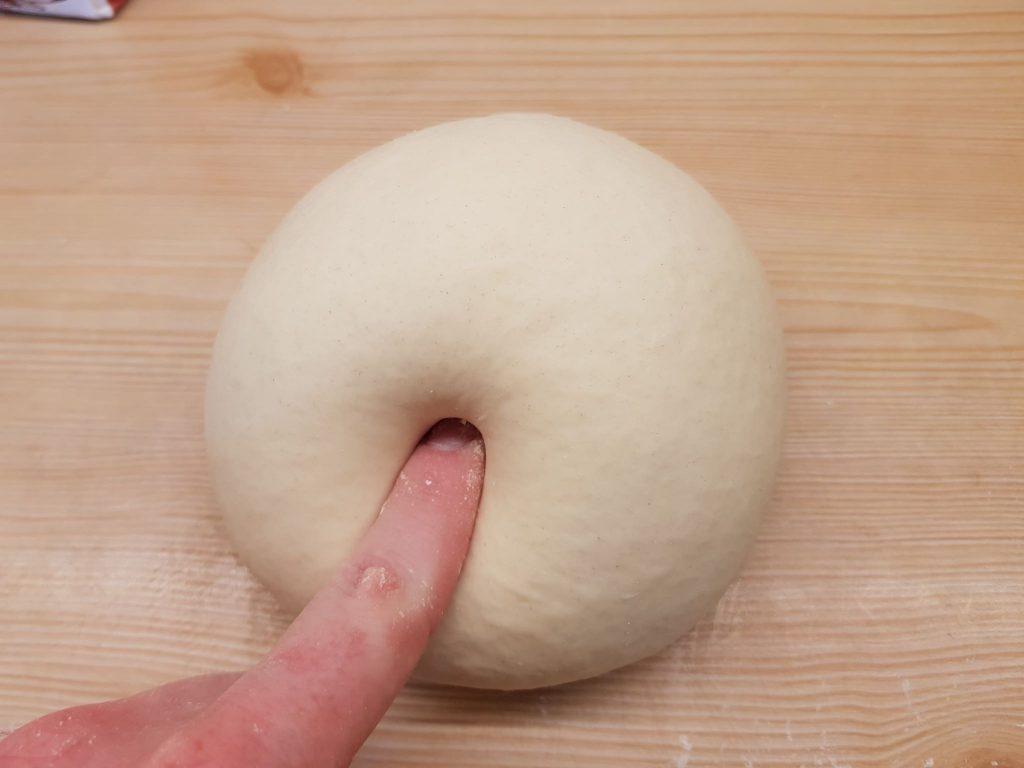
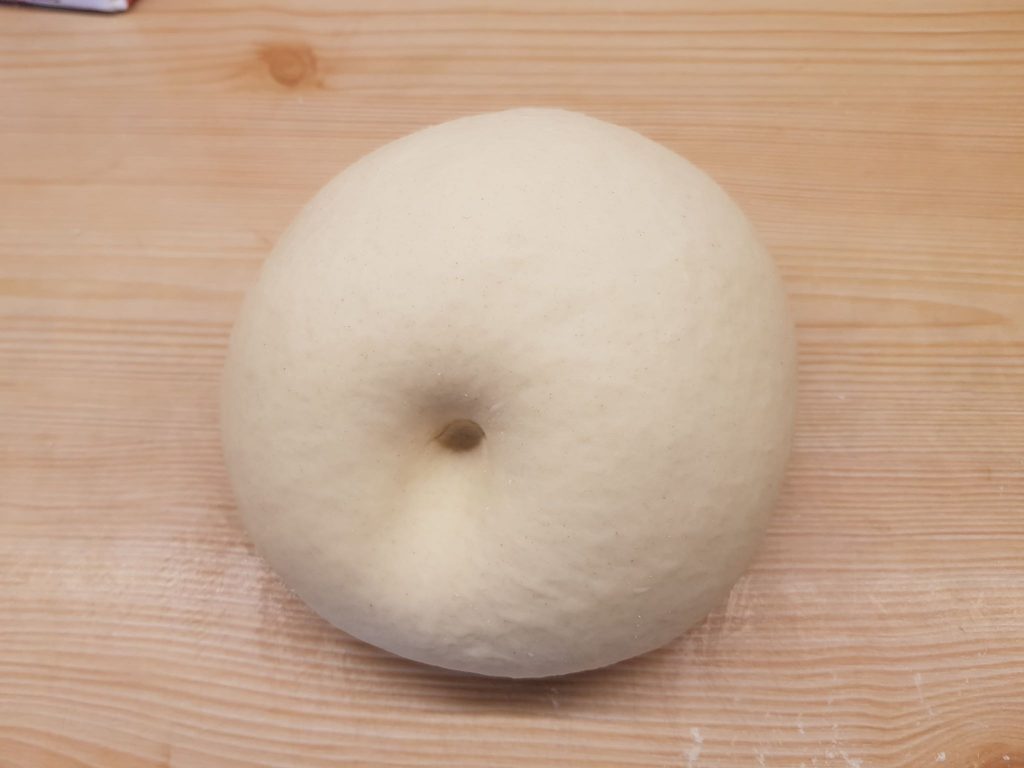
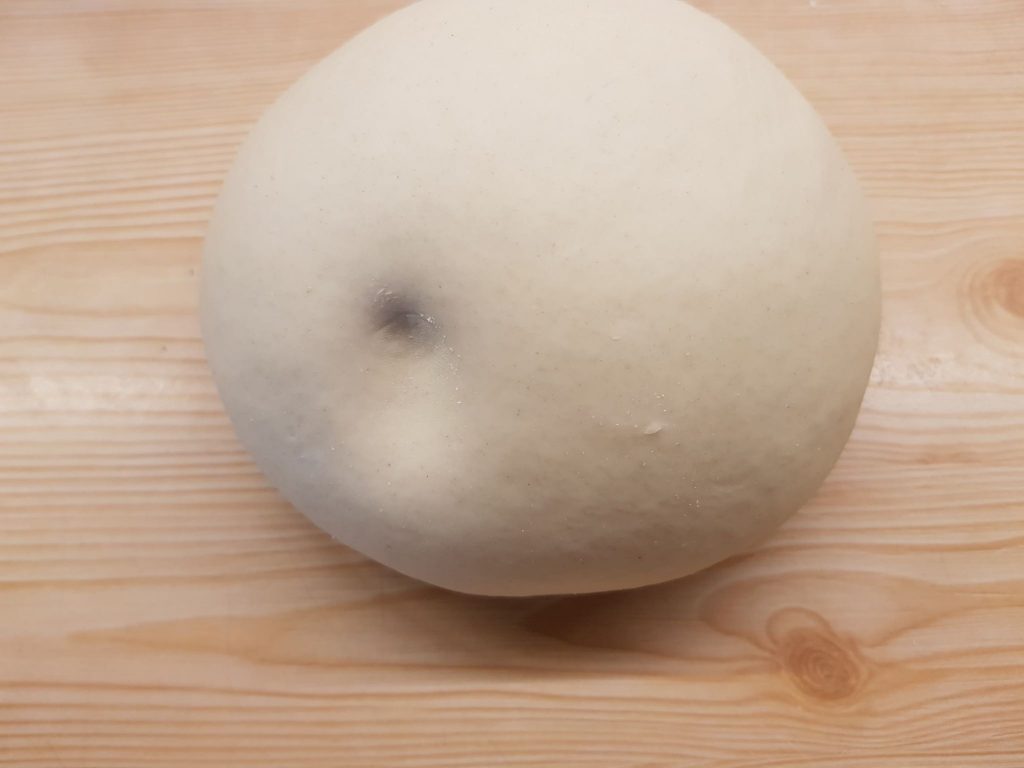
The Windowpane Test
Another easy way to check if the gluten has developed enough is to try to stretch it as thinly as possible. The dough should be able to get so thin that you can see through it without ripping it. If the dough rips, you need to knead the dough for a few more minutes.
Here’s an example of how it should not look like:
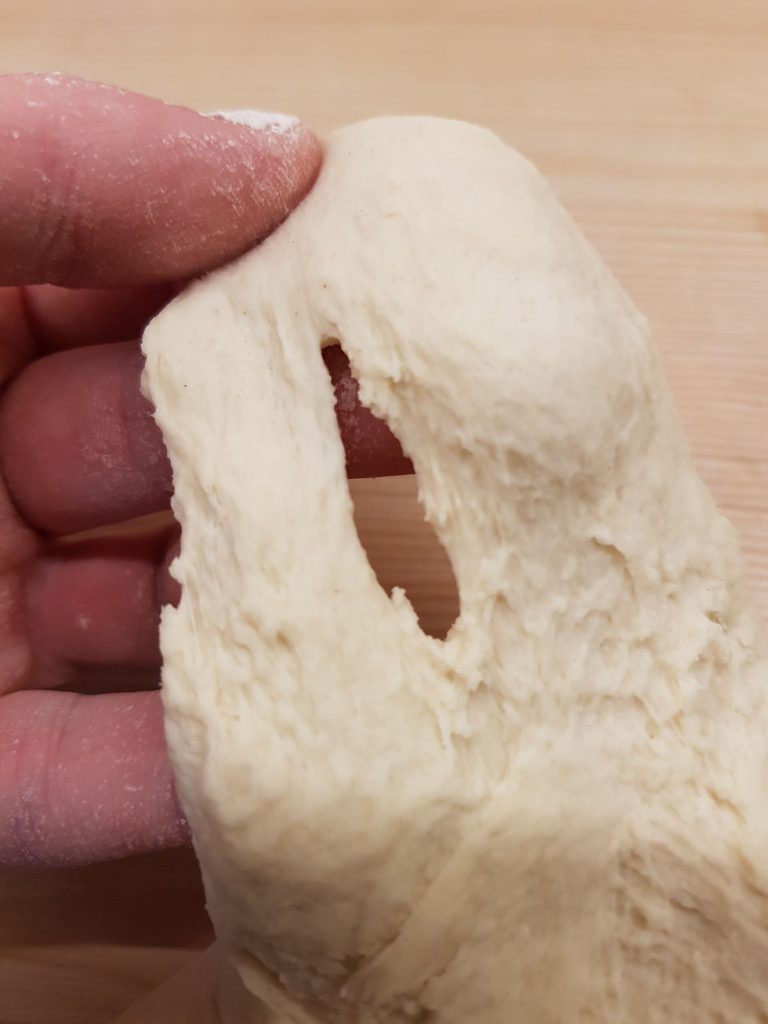
Here you can read more about how to properly perform The Windowpane Test.
You’re Using the Wrong Type of Flour
As mentioned earlier, how much you need to knead your pizza dough depends on the type of flour. A stronger flour, that contains more gluten, will develop faster, resulting in a tougher dough. An example of flour that contains too much gluten is bread flour. Bread flour will not make good pizza dough.
Three main factors affect the consistency of the dough. 1. the gluten content of the flour, 2. how finely ground flour is, and 3, the water absorption of the flour.
Gluten Content
I already briefly touched on how gluten development affects the dough. The more gluten the dough contains, the stronger the structures will be. On the other hand, if the gluten content is too low, you’ll end up with ad dough that’s too soft and doesn’t keep its shape during rising. You should, therefore, aim for a flour that’s somewhere in the middle, at around 11-12% gluten (protein) content. This is great for making pizza dough. The ideal flour in this gluten-content range is Italian Tipo 00 flour.
How Fine the Flour Is and How Well It Absorbs Water
The next thing that affects the dough’s consistency, is how fine the flour is. The reason is that fine flour will absorb water better, resulting in a softer dough. Italian Tipo 00 flour also is great when it comes to water absorption because it’s very finely milled.
What’s the Best Pizza Flour?
Because of its gluten content and water absorption ability, Italian Tipo 00 flour is the best choice for pizza making. Tipo 00 is also typically of very high quality since it’s made from the core of the wheat, and doesn’t contain brand and wheat middlings, like a lot of cheaper types of flour.
I, therefore, recommend going for a high-quality Tipo 00 flour. Flour is the one ingredient you should never skip because it’s the most important ingredient in pizza baking. Both when it comes to dough consistency and flavor.
There are many options out there, but I would look for an Italian imported Tipo 00 flour. A great example, and one of my favorites, is Caputo’s pizza flours. I have an article about Caputo pizza flours if you don’t know what to choose.
I also have an article on Tipo 00 flour for pizza baking if you want to know more about pizza flour, gluten, and the science behind it.
The Gluten Isn’t Relaxed Enough
Another reason your dough is too tough can be that the gluten isn’t relaxed enough. When you’re kneading pizza dough, and the gluten strains are developing, they get tense.
If the dough feels too tough to knead, you can let it rest a few minutes after combining all the ingredients, before you start kneading. This will also allow the flour to absorb the water properly and become softer and easier to work with.
Gluten relaxation shouldn’t be an issue when you’re stretching your pizza dough, after rising. The reason is that the gluten has time to relax when you rise the dough. The rising time can range from a couple of hours to several days the gluten will therefore have plenty of time to relax, and you’ll end up with a soft and pliable dough.
However, if your dough feels too dough when you’re working on stretching the dough, I recommend just letting it rest a few minutes before you continue. Never use a rolling pin, because this will ruin the edge of your pizza and you will end up with a flat and dry pizza crust.
The Yeast Isn’t Working
If your yeast isn’t working, you’ll end up with a tough, dense dough. The yeast’s job is to inflate the dough with CO2 by eating sugars in the flour. But three things can prevent the yeast from doing its job.
1. Kneading the Dough Too Little
The first reason is that the dough lacks gluten development. When you knead the dough, and the strains of gluten develop, it forms walls, that will trap gas inside the dough. This is the reason the dough is growing in volume and gets larger when it’s rising. If the gluten has not developed enough, the gluten walls will not be strong enough to trap the gas from the fermentation process. Gluten will also weaken over time, so if you leave the dough for too long, it can puncture, and let all the gas from the fermentation process out. In both situations, the result is tough dough.
It’s, therefore, important to also choose a flour that fits your fermentation time. If you want a 24-hour fermentation, you need stronger flour than for a 4-hour fermentation, for example.
2. The Yeast Is Dead
The second reason the yeast isn’t working is that can be dead. Yeast is a type of fungus, meaning it’s a living organism. When yeast is exposed to high temperatures, it can die. The temperature at yeast dies, depending on the species of yeast you use, but typically at around 120-140°F (50-60°C).
The yeast might also stop working if it’s too old. Fresh yeast usually has a shelf-life of around 3 weeks, while dry yeast usually lasts around 12 months.
3. The Yeast Is Inactive
Your yeast can also become inactive if you try to ferment your dough at a too low temperature. Yeast slows down in lower temperatures, and the lower the temperature, the slower the yeast will work. If it’s too cold it will even stop completely.
Sometimes, you actually want the yeast to slow down. An example of this is cold fermentation, where you intentionally leave the dough at a cold temperature to slow down the fermentation process. The goal of cold fermentation is to enhance the flavor of the pizza crusts, which comes from a slower fermentation process over a longer period of time. It is, however, important to make sure the dough is not too cold, or else the yeast will stop completely.
How to Check if the Yeast is working
When you’re baking Neapolitan-style pizza you typically don’t leave the yeast in lukewarm water to rehydrate, like in most bread recipes. You also usually want to use cooler water, because you want a longer, slower rising than for most types of bread. It’s therefore a little harder to know if your yeast is working.
Dry Yeast
Inactive yeast is mainly a problem if you’re using dry yeast. Dry yeast has a long shelf life and if it gets too old it can it may not work as well anymore.
To check if your dry yeast is active, what you can do to put a little bit of yeast in a glass of lukewarm water and leave a few minutes to see if starts to develop. You should be able to both see and smell the yeast after a few minutes. If the yeast is working, you can go ahead and make your pizza, the rest of these should be fine as well.
I personally use dry yeast all the time, because it’s very convenient due to the long shelf life. The yeast I’m using the most is Caputo Lievito, which is another great product from the Italian pizza mill Caputo.
You can read my review here to see why I love this yeast.
Fresh Yeast
For fresh yeast, you can usually see and smell if it’s good or not. When the yeast gets old, the outside starts to dry out and sometimes gets a darker color. This is a sign that your yeast has gone bad.
Too Short Proofing Time
Proofing time is also related to yeast. The yeast needs time to eat through the sugars in the dough and convert them into CO2. The CO2 will then inflate the dough and make it softer and more pliable. If you don’t leave the dough to ferment long enough, you will end up with a tough dough.
Another thing worth mentioning is that at colder temperatures, the proofing time needs to be increased because the yeast is slowed down. That means that a dough that’s rising at 75°F (24°C) for 8 hours, may need 24 hours at 60°F (15°C).
Another issue is Overproofing. This happens when the temperature at which you are rising the dough is too high. Overproofing means that the gluten structure rips, or punctures, and the CO2 escapes the dough. This will also result in a tough dough.
For How Long Should the Dough Be Proofing?
Many factors affect the proofing time, such as the type of flour, the amount of yeast, and the temperature. Generally speaking, in-room temperature pizza dough needs at least 4 to 8 hours. In a cooler room, the dough might need 24-hours. And if you’re cold-fermenting the dough in the frigid, as much as 3 to 5 days.
Related
- Is Your Pizza Dough Too Dry? Here is How to fix it! - June 10, 2024
- The Ultimate Guide to the Pizza Dough Windowpane Test - June 8, 2024
- The Ultimate Guide to Autolyse Pizza Dough - June 7, 2024
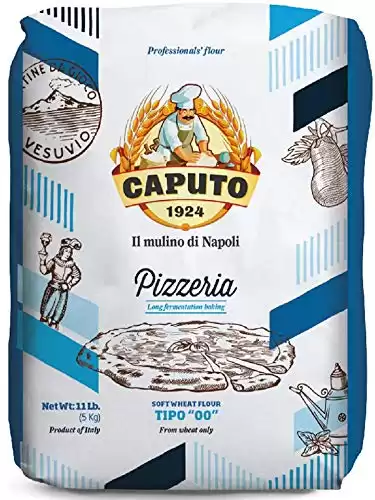


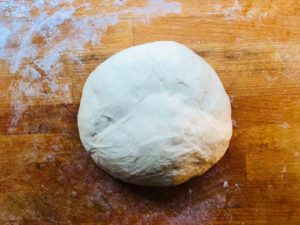
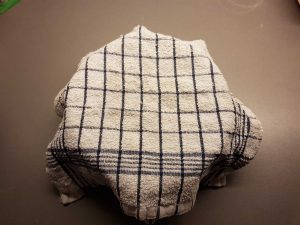
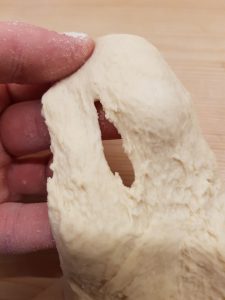

Wonderful info. I would, however, have someone correct the typing errors in the article. Otherwise, great stuff. Thank you.
I’m happy to hear that! And thank you for your feedback!
I have made many homemade pizzas, and my latest was the first to have a tough crust. I don’t think there were any of the issues you listed. This was the first time that I refrigerated the dough overnight. I let the dough rise for 4 hours first. Because I was refrigerating it, I put it
in a big bowl lightly greased with olive oil. If I had put it on a floured pastry cloth, as I did before, would this have made a more tender crust? Thank you for your help.
Thank you. You mentioned a few things I will alter to get a smoother softer dough.
I’ve made pizza dough for years but the last two batches have resulted in tough dough with little flavour. And I have to say, four of the possible problems you list seem like likely culprits. I recently bought lovely bread flour that I assumed I could use for pizza. My yeast may be getting to the end of its life. The recipe I’ve been using recently calls for way too much flour and for 15 minutes of kneading. Thanks for all of this great advice!